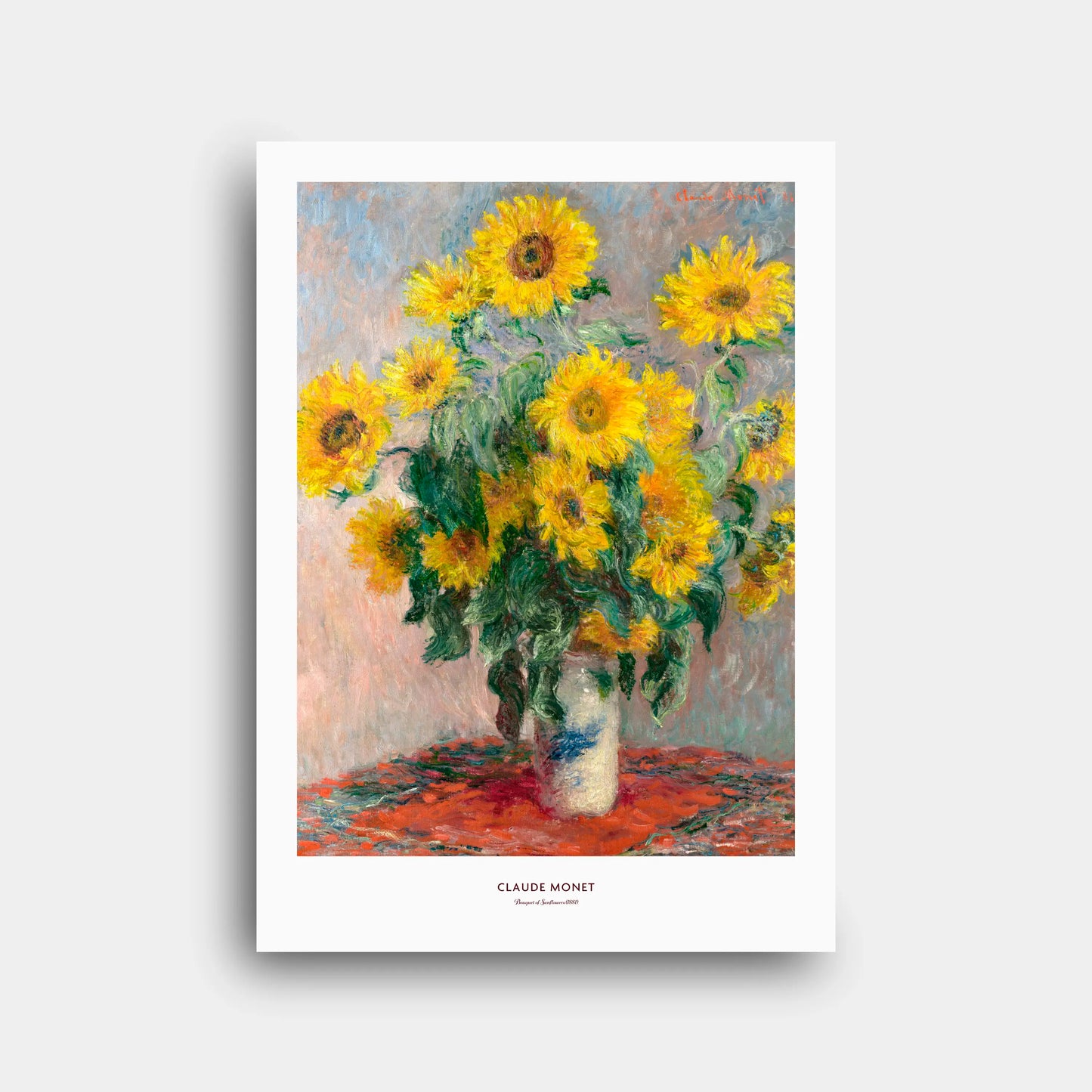Claude Monet - Bouquet of Sunflowers (1881) - Paper Poster N157
Claude Monet - Bouquet of Sunflowers (1881) - Paper Poster N157
Couldn't load pickup availability
Share
Paper Poster | Canvas Print | Digital File
1. Historical and Artistic Context
Claude Monet painted “Bouquet of Sunflowers” in 1881 during his years at Vétheuil, a period marked by both artistic productivity and personal struggle. Monet was living in a small village along the Seine, dealing with financial hardship and the loss of his wife, Camille. Yet, amidst these difficulties, he found inspiration in his garden and the surrounding nature. This work is part of a short series of floral still lifes created when bad weather kept him from painting outdoors. At the Seventh Impressionist Exhibition in 1882, Monet exhibited this work under the title “Bouquet de soleils,” presenting a traditional subject—still life flowers—through his distinctly modern Impressionist lens.
2. Technical and Stylistic Analysis
The composition is dynamic and slightly asymmetrical. The vase is positioned off-center, and the flowers extend beyond the edges of the canvas, creating a sense of immediacy. Monet uses broad, vigorous brushstrokes that convey movement and vitality. The yellow blossoms are depicted with thick impasto, while the surrounding leaves and stems are built from layered greens and blues that give depth and complexity. The background is a blend of soft pinks, blues, and violets, which makes the intense yellows of the sunflowers vibrate even more. Monet’s use of complementary colors and cropped framing reflects his interest in Japanese prints and demonstrates his mastery in orchestrating color harmonies.
3. Symbolism and Interpretation
Although Monet was not primarily concerned with symbolism, the subject naturally carries layered meanings. Sunflowers, associated with the sun and vitality, stand here as radiant symbols of energy and abundance. At the same time, some drooping stems and wilted leaves remind the viewer of the fleeting nature of life and beauty. Unlike Van Gogh’s later, more symbolic sunflowers, Monet’s are portrayed collectively, more as a glowing mass of color than as individual personalities. The Asian blue-and-white vase introduces an exotic element, reflecting both France’s fascination with Japonisme and the cosmopolitan influences on Monet’s art.
4. Technique and Materials
The painting is executed in oil on canvas, measuring about 101 × 81.3 cm, a substantial size for a floral still life. Monet applied thick impasto to the petals, giving them a tactile, almost sculptural quality. The foliage is painted with sweeping, twisting strokes, creating a sense of natural disorder that contrasts with the static form of the vase. Edges often dissolve into the background, then reappear with a brighter touch of color, a hallmark of Impressionist technique. The blue-and-white porcelain vase, possibly Chinese or Japanese, is painted not with precise lines but with broken color strokes that suggest rather than describe its reflective surface.
5. Cultural Impact
“Bouquet of Sunflowers” played an important role in spreading Impressionism beyond France. After appearing at the 1882 Impressionist Exhibition, it was shown in Brussels at the avant-garde group Les XX in 1886 and later in New York at the National Academy of Design the same year. These international showings helped to introduce Monet’s work to new audiences, especially in America. Notably, the painting influenced Van Gogh, who admired Monet’s treatment of sunflowers and later developed his own celebrated sunflower series. Today, the work continues to inspire viewers and stands as one of the defining examples of floral Impressionist still life.
6. Critical Reception and Scholarly Interpretations
When first exhibited, critics noted the brilliance and audacity of Monet’s brushwork, praising the way he transformed a conventional still life into an energetic vision of light and color. Later scholars highlighted the Japanese influence in the cropping and composition. Comparisons with Van Gogh’s sunflower paintings have become a common point of discussion, showing how Monet’s collective, luminous approach contrasts with Van Gogh’s intense, individualized vision. In the United States, after entering the Havemeyer Collection and later The Metropolitan Museum of Art, the painting was praised as a masterpiece of floral Impressionism, celebrated for its dazzling chromatic orchestration.
7. Museum, Provenance and Exhibition History
The painting is now part of the collection of The Metropolitan Museum of Art in New York, acquired in 1929 through the Havemeyer bequest. Its provenance includes Durand-Ruel, the famous Impressionist dealer, and American collectors such as Alden Wyman Kingman and Catholina Lambert. It was exhibited at key venues: the Seventh Impressionist Exhibition in Paris (1882), Durand-Ruel’s gallery in 1883, the Les XX exhibition in Brussels in 1886, and the National Academy of Design in New York in 1886. Each exhibition extended the painting’s reputation and helped shape its status as one of Monet’s most iconic still lifes.
8. Interesting Facts
1. Monet painted around twenty floral still lifes between 1878–1883.
2. It was shown at the 1882 Impressionist Exhibition as “Bouquet de soleils.”
3. The sunflowers came from Monet’s own garden at Vétheuil.
4. The composition reflects Japanese influence with cropped edges.
5. Monet orchestrated color contrasts: yellow flowers vs violet-pink background.
6. Gauguin admired this work and discussed it with Van Gogh.
7. Van Gogh later referenced Monet’s sunflowers in letters.
8. The variety used here is smaller “soleils,” different from Van Gogh’s “tournesols.”
9. The same vase appears in other Monet still lifes.
10. The painting was among the earliest Impressionist works exhibited in the U.S.
9. Conclusion
“Bouquet of Sunflowers” is more than a still life; it is a celebration of light, color, and vitality, painted during a moment of hardship in Monet’s life. Through its dazzling yellows, dynamic brushwork, and cosmopolitan details, it exemplifies Impressionism’s ability to transform ordinary subjects into luminous visions. The painting bridges traditional still life with modern technique, influenced Van Gogh, and contributed to the global spread of Impressionism. Today, it stands as one of Monet’s most beloved works, admired for both its aesthetic brilliance and its historical significance.











